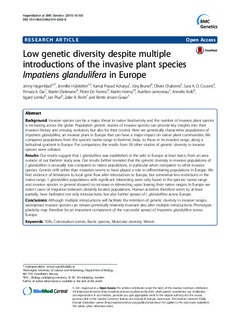| dc.contributor.author | Hagenblad, Jenny | |
| dc.contributor.author | Hülskötter, Jennifer | |
| dc.contributor.author | Acharya, Kamal Prasad | |
| dc.contributor.author | Brunet, Jörg | |
| dc.contributor.author | Chabrerie, Olivier | |
| dc.contributor.author | Cousins, Sara A.O. | |
| dc.contributor.author | Dar, Pervaiz A | |
| dc.contributor.author | Diekmann, Martin | |
| dc.contributor.author | De Frenne, Pieter | |
| dc.contributor.author | Hermy, Martin | |
| dc.contributor.author | Jamoneau, Aurelien | |
| dc.contributor.author | Kolb, Anette | |
| dc.contributor.author | Lemke, Isgard | |
| dc.contributor.author | Plue, Jan | |
| dc.contributor.author | Reshi, Zafar A | |
| dc.contributor.author | Graae, Bente Jessen | |
| dc.date.accessioned | 2019-11-29T07:16:56Z | |
| dc.date.available | 2019-11-29T07:16:56Z | |
| dc.date.created | 2015-10-22T12:13:51Z | |
| dc.date.issued | 2015 | |
| dc.identifier.citation | BMC Genetics. 2015, 16 (103), . | nb_NO |
| dc.identifier.issn | 1471-2156 | |
| dc.identifier.uri | http://hdl.handle.net/11250/2630958 | |
| dc.description.abstract | Background
Invasive species can be a major threat to native biodiversity and the number of invasive plant species is increasing across the globe. Population genetic studies of invasive species can provide key insights into their invasion history and ensuing evolution, but also for their control. Here we genetically characterise populations of Impatiens glandulifera, an invasive plant in Europe that can have a major impact on native plant communities. We compared populations from the species’ native range in Kashmir, India, to those in its invaded range, along a latitudinal gradient in Europe. For comparison, the results from 39 other studies of genetic diversity in invasive species were collated.
Results
Our results suggest that I. glandulifera was established in the wild in Europe at least twice, from an area outside of our Kashmir study area. Our results further revealed that the genetic diversity in invasive populations of I. glandulifera is unusually low compared to native populations, in particular when compared to other invasive species. Genetic drift rather than mutation seems to have played a role in differentiating populations in Europe. We find evidence of limitations to local gene flow after introduction to Europe, but somewhat less restrictions in the native range. I. glandulifera populations with significant inbreeding were only found in the species’ native range and invasive species in general showed no increase in inbreeding upon leaving their native ranges. In Europe we detect cases of migration between distantly located populations. Human activities therefore seem to, at least partially, have facilitated not only introductions, but also further spread of I. glandulifera across Europe.
Conclusions
Although multiple introductions will facilitate the retention of genetic diversity in invasive ranges, widespread invasive species can remain genetically relatively invariant also after multiple introductions. Phenotypic plasticity may therefore be an important component of the successful spread of Impatiens glandulifera across Europe. | nb_NO |
| dc.language.iso | eng | nb_NO |
| dc.publisher | BioMed Central | nb_NO |
| dc.rights | Navngivelse 4.0 Internasjonal | * |
| dc.rights.uri | http://creativecommons.org/licenses/by/4.0/deed.no | * |
| dc.title | Low genetic diversity despite multiple introductions of the invasive plant species Impatiens glandulifera in Europe | nb_NO |
| dc.type | Journal article | nb_NO |
| dc.type | Peer reviewed | nb_NO |
| dc.description.version | publishedVersion | nb_NO |
| dc.source.pagenumber | 16 | nb_NO |
| dc.source.volume | 16 | nb_NO |
| dc.source.journal | BMC Genetics | nb_NO |
| dc.source.issue | 103 | nb_NO |
| dc.identifier.doi | 10.1186/s12863-015-0242-8 | |
| dc.identifier.cristin | 1282664 | |
| dc.description.localcode | Open Access This article is distributed under the terms of the Creative Commons Attribution 4.0 International License (http://creativecommons.org/licenses/by/4.0/), which permits unrestricted use, distribution, and reproduction in any medium, provided you give appropriate credit to the original author(s) and the source, provide a link to the Creative Commons license, and indicate if changes were made. The Creative Commons Public Domain Dedication waiver (http://creativecommons.org/publicdomain/zero/1.0/) applies to the data made available in this article, unless otherwise stated. | nb_NO |
| cristin.unitcode | 194,66,10,0 | |
| cristin.unitname | Institutt for biologi | |
| cristin.ispublished | true | |
| cristin.fulltext | original | |
| cristin.qualitycode | 1 | |

